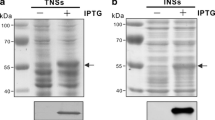Summary
A panel of ten stable hybridoma cell lines secreting monoclonal antibodies (MAbs) specific for potato leafroll virus (PLRV) antigen, was produced in two fusion experiments with murine splenic and myeloma cells. Using different ELISA procedures and Western blotting it was shown that one MAb detected a continuous epitope and nine MAbs reacted with conformation-dependent ones. The conformation-dependent epitopes could be separated into two groups after alkaline treatment of the virions. The MAbs were further differentiated in competitive binding assays. Within the group of MAbs reacting with epitopes not sensitive to alkaline degradation, only two MAbs were directed to the same epitope. The MAbs detecting epitopes formed by the quaternary protein structure or by a protein subunit configuration sensitive to alkaline degradation, displayed positive cooperative binding among each other. In total, a minimum number of nine different, but overlapping, epitopes on the PLRV coat protein could be revealed.
The immune response to PLRV antigen in rabbit appeared to be directed mainly towards epitopes recognized by three MAbs.
Most MAbs displayed heterologous reactivity to other luteoviruses, i.e., tomato yellow top virus (TYTV), beet western yellow virus (BWYV), beet mild yellowing virus (BMYV), bean leafroll virus (BLRV), and different strains of barley yellow dwarf virus. Three MAbs solely reacted with PLRV and TYTV. Six MAbs gave different reaction patterns in these tests; one of these MAbs differentiated BMYV from BWYV, and another detected a common epitope on PLRV and BLRV, a serological relationship not reported previously to our knowledge.
Similar content being viewed by others
References
Caspar R (1988) Luteoviruses. In: Koenig R (ed) The plant viruses: polyhedral virions with monopartite RNA genomes. Plenum, New York, pp 235–258
Cepica A, Yason C, Ralling G (1990) The use of ELISA for detection of the antibody-induced conformational change in a viral protein and its intermolecular spread. J Virol Methods 28: 1–14
d'Arcy CJ, Torrance L, Martin RR (1989) Discrimination among luteoviruses and their strains by monoclonal antibodies and identification of common epitopes. Phytopathology 79: 869–873
Harrison BD (1984) Potato leafroll virus. CMI/AAB Descriptions of plant viruses, no 291
Hsu HT, Aebig J, Rochow WF (1984) Differences among monoclonal antibodies to barley yellow dwarf viruses. Phytopathology 74: 600–605
Lane RD (1985) A short-duration polyethylene glycol fusion technique for increasing production of monoclonal antibody-secreting hybridomas. J Immunol Methods 81: 223–228
Martin RR, Stace-Smith R (1984) Production and characterization of monoclonal antibodies specific to potato leafroll virus. Can J Plant Pathol 6: 206–210
Massalski PR, Harrison BD (1987) Properties of monoclonal antibodies to potato leafroll luteovirus and their use to distinguish virus isolates differing in aphid transmissibility. J Gen Virol 68: 1813–1821
Ohshima K, Uyeda I, Shikata E (1988) Production and characteristics of monoclonal antibodies to potato leafroll virus. J Fac Agricult Hokkaido Univ 63: 373–383
Ohshima K, Uyeda I, Shikata E (1989) Characterization of monoclonal antibodies against tobacco necrotic dwarf virus. Ann Phytopathol Soc Japan 55: 420–426
Pead MT, Torrance L (1988) Some characteristics of monoclonal antibodies to a British MAV-like isolate of barley yellow dwarf virus. Ann Appl Biol 113: 639–644
Schots A (1989) A serological approach to the identification of potato cyst nematodes. PhD thesis, Wageningen Agricultural University, the Netherlands
Takanami Y, Kubo S (1979) Enzyme-assisted purification of two phloem-limited plant viruses: tobacco necrotic dwarf and potato leafroll. J Gen Virol 44: 153–159
Torrance L, Pead MT, Larkins AP, Butcher GW (1986) Characterization of monoclonal antibodies to a U.K. isolate of barley yellow dwarf virus. J Gen Virol 67: 549–556
Towbin H, Staehelin G, Gordon J (1979) Electrophoretic transfer of protein from polyacrylamide gels to nitrocellulose sheets: procedure and some applications. Proc Natl Acad Sci USA 76: 4350–4354
van den Heuvel JFJM, Peters D (1989) Improved detection of potato leafroll virus in leaf material and in aphids. Phytopathology 79: 963–967
Waterhouse PM, Gildow FE, Johnstone GR (1988) Luteovirus group. CMI/AAB Descriptions of plant viruses, no 339
Wilk F van der, Huisman MJ, Cornelissen BJC, Huttinga H, Goldbach R (1989) Nucleotide sequence and organization of potato leafroll virus genomic RNA. FEBS Lett 245: 51–56
Yewdell JW, Gerhard W (1981) Antigenic characterization of viruses by monoclonal antibodies. Annu Rev Microbiol 35: 185–206
Zrein M, Burckard J, Van Regenmortel MHV (1986) Use of the biotin-avidin system for detecting a broad range of serologically related plant viruses by ELISA. J Virol Methods 13: 121–128
Author information
Authors and Affiliations
Rights and permissions
About this article
Cite this article
van den Heuvel, J.F.J.M., de Blank, C.M., Goldbach, R.W. et al. A characterization of epitopes on potato leafroll virus coat protein. Archives of Virology 115, 185–197 (1990). https://doi.org/10.1007/BF01310529
Received:
Accepted:
Issue Date:
DOI: https://doi.org/10.1007/BF01310529




